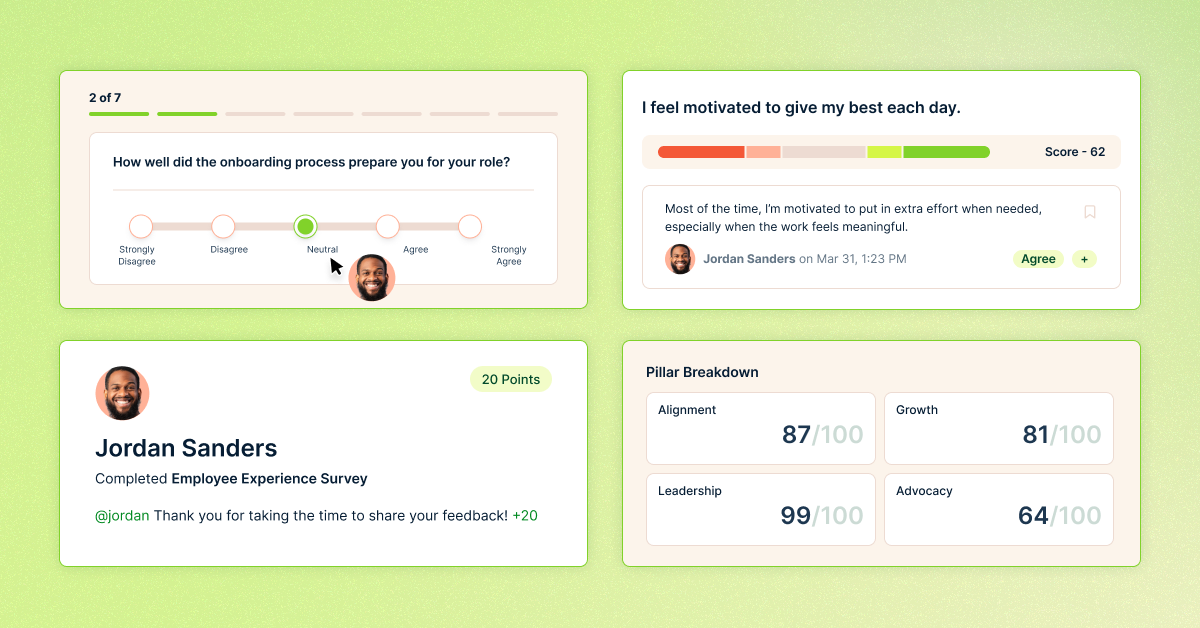Health & wellness
.svg)
Health & Wellness
What is Health & Wellness?
Health & Wellness in the context of company culture refers to the holistic approach organizations take to support their employees' physical, mental, and emotional well-being. This encompasses a variety of initiatives and programs designed to foster a healthy work environment, promote a balanced lifestyle, and encourage employees to prioritize their health. It includes aspects such as physical fitness programs, mental health resources, flexible working arrangements, and a supportive workplace culture that values well-being.
Why is Health & Wellness Important?
Health & Wellness is crucial for organizations for several reasons. Firstly, a focus on employee well-being directly influences job satisfaction and engagement levels. When employees feel valued and supported in their health, they are more likely to be motivated, productive, and committed to their work. Secondly, organizations benefit from reduced absenteeism and lower healthcare costs, as healthier employees tend to take fewer sick days and require less medical attention. This, in turn, enhances overall company performance, as a healthy workforce is more efficient and innovative.
Moreover, a culture that prioritizes health & wellness contributes to a positive workplace environment. It fosters a sense of community and belonging among employees, which enhances collaboration and teamwork. Lastly, in an era where job seekers are increasingly considering company culture, organizations that promote health & wellness are more attractive to top talent, aiding in recruitment and retention efforts.
How to Implement Health & Wellness?
To effectively integrate Health & Wellness into an organization's culture, the following actionable steps can be taken:
- Assess Employee Needs: Conduct surveys or focus groups to understand the specific health & wellness needs and preferences of employees.
- Develop Programs: Create diverse programs that cater to various aspects of health, including physical fitness (e.g., gym memberships, yoga classes), mental health (e.g., counseling services, stress management workshops), and nutrition (e.g., healthy eating initiatives).
- Promote Work-Life Balance: Implement flexible work arrangements, such as remote work options or adjustable hours, to help employees manage their personal and professional lives effectively.
- Create a Supportive Environment: Foster a culture that encourages open discussions about health and wellness, providing resources and support without stigma.
- Evaluate and Adjust: Regularly assess the effectiveness of health & wellness initiatives through feedback and metrics, making necessary adjustments to improve outcomes.
Benefits of Health & Wellness
Organizations that successfully embrace Health & Wellness can expect several tangible advantages:
- Increased Productivity: Healthy employees typically exhibit higher levels of productivity and efficiency.
- Enhanced Employee Engagement: A supportive culture leads to greater employee satisfaction and engagement.
- Lower Healthcare Costs: Preventative health measures can result in reduced health insurance premiums and costs associated with absenteeism.
- Attracting Talent: Companies that prioritize well-being have a competitive edge in attracting and retaining skilled employees.
- Improved Workplace Morale: A focus on well-being fosters a positive work environment, enhancing employee morale and collaboration.
Common Challenges with Health & Wellness
Despite its benefits, organizations may face several challenges when implementing Health & Wellness initiatives:
- Budget Constraints: Limited resources can restrict the scope of wellness programs. To overcome this, organizations can start with low-cost initiatives, such as wellness challenges or lunch-and-learns.
- Employee Engagement: Employees may be skeptical or indifferent toward wellness programs. To address this, organizations should involve employees in the planning process and promote programs effectively.
- Sustainability: Maintaining momentum over time can be difficult. Organizations should regularly review and adapt programs to keep them relevant and engaging.
By proactively addressing these challenges and prioritizing Health & Wellness, organizations can create a thriving workplace that benefits both employees and the organization as a whole.





